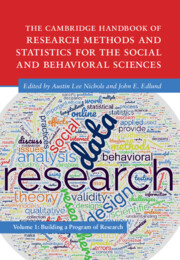 The Cambridge Handbook of Research Methods and Statistics for the Social and Behavioral Sciences
The Cambridge Handbook of Research Methods and Statistics for the Social and Behavioral Sciences from Part III - Data Collection
Published online by Cambridge University Press: 25 May 2023
Cross-sectional studies are a type of observational studies in which the researcher commonly assesses the exposure, outcome, and other variables (such as confounding variables) at the same time. They are also referred to as “prevalence studies.” These studies are useful in a range of disciplines across the social and behavioral sciences. The common statistical estimates from these studies are correlation values, prevalence estimates, prevalence odds ratios, and prevalence ratios. These studies can be completed relatively quickly, are relatively inexpensive to conduct, and may be used to generate new hypotheses. However, the major limitation of these studies are biases due to sampling, length-time bias, same source bias, and the inability to have a clear temporal association between exposure and outcome in many scenarios. The researcher should be careful while interpreting the measure of association from these studies, as it may not be appropriate to make causal inferences from these associations.
The following are sources that describe various aspects of cross-sectional studies.
To save this book to your Kindle, first ensure [email protected] is added to your Approved Personal Document E-mail List under your Personal Document Settings on the Manage Your Content and Devices page of your Amazon account. Then enter the ‘name’ part of your Kindle email address below. Find out more about saving to your Kindle.
Note you can select to save to either the @free.kindle.com or @kindle.com variations. ‘@free.kindle.com’ emails are free but can only be saved to your device when it is connected to wi-fi. ‘@kindle.com’ emails can be delivered even when you are not connected to wi-fi, but note that service fees apply.
Find out more about the Kindle Personal Document Service.
To save content items to your account, please confirm that you agree to abide by our usage policies. If this is the first time you use this feature, you will be asked to authorise Cambridge Core to connect with your account. Find out more about saving content to Dropbox.
To save content items to your account, please confirm that you agree to abide by our usage policies. If this is the first time you use this feature, you will be asked to authorise Cambridge Core to connect with your account. Find out more about saving content to Google Drive.